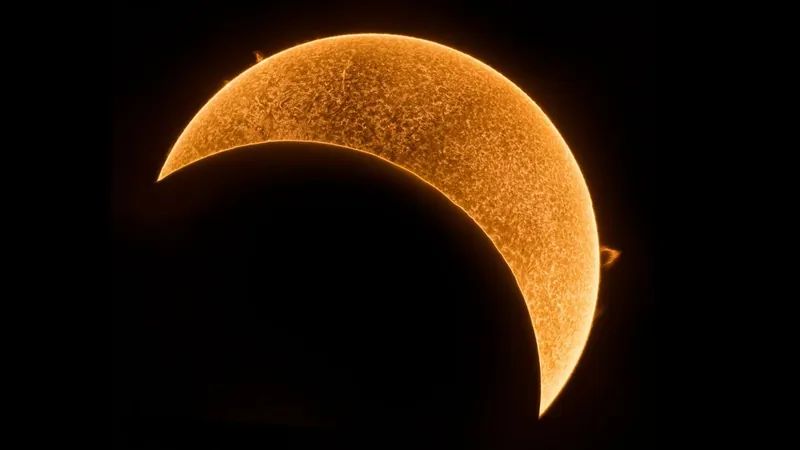
What to Expect During Tomorrow's Partial Solar Eclipse: A Celestial Event!
2025-03-28
Author: Ken Lee
What to Expect During Tomorrow's Partial Solar Eclipse: A Celestial Event!
Tomorrow, March 29, the skies will host a captivating partial solar eclipse, a sight that, while less dramatic than the spectacular total eclipse a year ago, still offers a unique opportunity for skywatchers across certain regions of the world.
Unlike last year's highly publicized total eclipse that captivated millions in North America, tomorrow's event will feature the moon's shadow primarily grazing the polar regions. The partial eclipse will be visible from various locations, including much of Europe, northwest Russia, Iceland, and Greenland, with some regions in South America also catching a glimpse.
Eclipse Season Highlights
The upcoming eclipse is notable as it falls within an eclipse season, a period lasting about 37 days when the alignment of the sun and moon allows for both lunar and solar eclipses. Just two weeks prior on March 13-14, a total lunar eclipse dazzled watchers as the moon passed through the Earth's shadow. Now, as the moon nears its new phase and crosses the ecliptic's opposite node, it will create the solar eclipse.
However, the alignment is not quite perfect. The moon will reach its new phase shortly after crossing the ecliptic, resulting in its shadow missing Earth entirely by about 180 miles above the North Pole. Thus, instead of a total eclipse, observers will witness a more subdued partial eclipse.
Viewing Locations and Timing
In locations like southern Ontario and Virginia Beach, the eclipse will be visible just after sunrise. For example, in Baltimore, Maryland, about 7.8% of the sun will be obscured at the moment of sunrise, which is at 6:58 AM EDT. As you head north and east, the eclipse will cover a greater portion of the sun.
Notably, in the town of Madawaska, Maine, the maximum eclipse coincides with sunrise at 6:17 AM EDT. Observers there can look forward to 88.2% coverage as the sun rises, creating a stunning crescent shape against the horizon.
Safety First!
It’s crucial to remember that looking directly at the sun without the proper protection can cause serious eye damage. Unlike total eclipses, where darkness envelops the sky, a partial eclipse requires proper eyewear. Solar filters or eclipse glasses should always be used for safe viewing. A range of solar eclipse gear is available, making it easier for enthusiasts to safely enjoy the event.
Where to Catch the Best Views
For those looking for the best vantage point with maximum coverage, Nunavik in Quebec, Canada, will be the prime location, where nearly 94% of the sun will be obscured. Observers can expect a unique visual effect, as atmospheric conditions might enhance the brilliance of the slender crescent that will be visible above the horizon.
Tomorrow's partial solar eclipse may not be as grand as its total counterpart but offers a fantastic chance to witness a remarkable celestial event. Make sure to prepare properly, grab your eclipse glasses, and enjoy the show!


 Brasil (PT)
Brasil (PT)
 Canada (EN)
Canada (EN)
 Chile (ES)
Chile (ES)
 Česko (CS)
Česko (CS)
 대한민국 (KO)
대한민국 (KO)
 España (ES)
España (ES)
 France (FR)
France (FR)
 Hong Kong (EN)
Hong Kong (EN)
 Italia (IT)
Italia (IT)
 日本 (JA)
日本 (JA)
 Magyarország (HU)
Magyarország (HU)
 Norge (NO)
Norge (NO)
 Polska (PL)
Polska (PL)
 Schweiz (DE)
Schweiz (DE)
 Singapore (EN)
Singapore (EN)
 Sverige (SV)
Sverige (SV)
 Suomi (FI)
Suomi (FI)
 Türkiye (TR)
Türkiye (TR)
 الإمارات العربية المتحدة (AR)
الإمارات العربية المتحدة (AR)